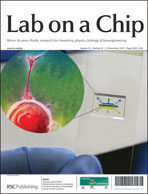High-frequency nanofluidics: a universal formulation of the fluid dynamics of MEMS and NEMS
Abstract
A solid body undergoing oscillatory motion in a fluid generates an oscillating flow. Oscillating flows in Newtonian fluids were first treated by G.G. Stokes in 1851. Since then, this problem has attracted much attention, mostly due to its technological significance. Recent advances in micro- and nanotechnology require that this problem be revisited: miniaturized mechanical resonators with linear dimensions in microns and sub-microns—microelectromechanical systems (MEMS) and nanoelectromechanical systems (NEMS), respectively—give rise to oscillating flows when operated in fluids. Yet flow parameters for these devices, such as the characteristic flow time and length scales, may deviate greatly from those in Stokes' solution. As a result, new and interesting physics emerges with important consequences to device applications. In this review, we shall provide an introduction to this area of fluid dynamics, called high-frequency nanofluidics, with emphasis on both theory and experiments.


 Please wait while we load your content...
Please wait while we load your content...